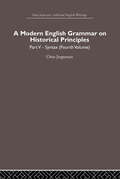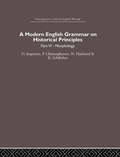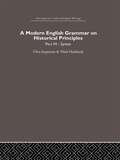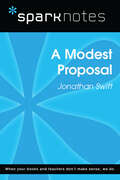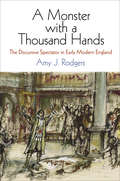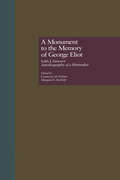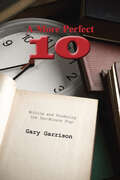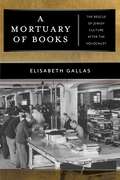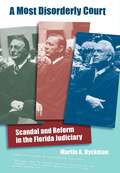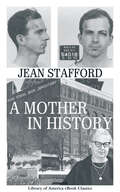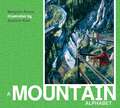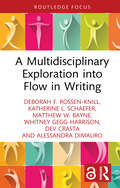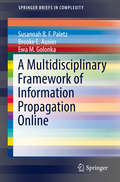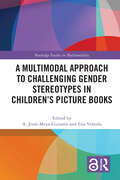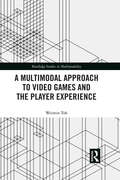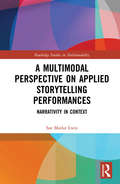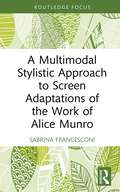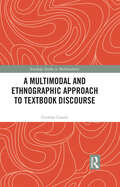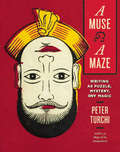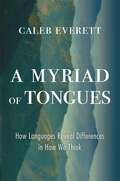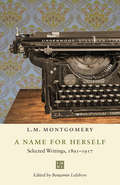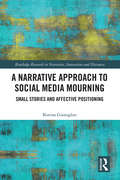- Table View
- List View
A Modern English Grammar on Historical Principles: Volume 5, Syntax (fourth volume)
by Otto JespersenThis book was first published in 1954, A Modern English Grammar on Historical Principles is a valuable contribution to the field of English Language and Linguistics.
A Modern English Grammar on Historical Principles: Volume 6
by Otto Jespersen Niels Haislund Knud Schibsbye Paul ChristophersenIn Morphology the first thing to be considered is the form, and second to that comes the use made of it, in Syntax the order is exactly the reverse, but it is essential that in both parts of the grammar form and use should be mentioned in every case. Volume 6 looks at English Morphology including subjects such as personal endings in verbs, tense formation in verbs, the naked word, compounds, change of vowels, suffixes, and the endings s, st and n, to name a few.
A Modern English Grammar on Historical Principles: Volume 7. Syntax
by Otto JespersenThis book is the seventh and last volume of that great work by Otto Jespersen the first volume of which was published in 1909. This volume looks at English Syntax including subjects such as sentence structure, word classes, word order, cases, comparison and determination.
A Modest Proposal (SparkNotes Literature Guide Series)
by SparkNotesA Modest Proposal (SparkNotes Literature Guide) by Jonathan Swift Making the reading experience fun! Created by Harvard students for students everywhere, SparkNotes is a new breed of study guide: smarter, better, faster. Geared to what today's students need to know, SparkNotes provides: *Chapter-by-chapter analysis *Explanations of key themes, motifs, and symbols *A review quiz and essay topicsLively and accessible, these guides are perfect for late-night studying and writing papers
A Momentary Glory: Last Poems (Wesleyan Poetry Series)
by Harvey ShapiroThe passionate testament of a brilliant poet in the face of age, illness, and mortality The distinguished poet Harvey Shapiro passed away on January 7, 2013. The poems in this book, many of them previously unpublished and discovered only after his death, are a great gift, and the final confirmation of his extraordinary talent. Edited by Shapiro's literary executor, the poet and critic Norman Finkelstein, these last poems bear an unprecedented gravitas, and yet they are as supple, jazzy, and edgy as Shapiro's earlier work. All the themes for which he is known are beautifully represented here. There are poems of his experiences in World War II, the erotic life, and of daily moments in Brooklyn and Manhattan, all in search of a worldly wisdom and grace that the poet calls "a momentary glory." As Shapiro tells us, the poem "Is an Egyptian / ship of the dead, / everything required / for life stored / in its hold." The book includes an introduction by the editor.
A Monster with a Thousand Hands: The Discursive Spectator in Early Modern England
by Amy J. RodgersA Monster with a Thousand Hands makes visible a figure that has been largely overlooked in early modern scholarship on theater and audiences: the discursive spectator, an entity distinct from the actual bodies attending early modern English playhouses. Amy J. Rodgers demonstrates how the English commercial theater's rapid development and prosperity altered the lexicon for describing theatergoers and the processes of engagement that the theater was believed to cultivate. In turn, these changes influenced and produced a cultural projection—the spectator—a figure generated by social practices rather than a faithful recording of those who attended the theater. The early modern discursive spectator did not merely develop alongside the phenomenological one, but played as significant a role in shaping early modern viewers and viewing practices as did changes to staging technologies, exhibition practices, and generic experimentation.While audience and film studies have theorized the spectator, these fields tend to focus on the role of twentieth-century media (film, television, and the computer) in producing mass-culture viewers. Such emphases lead to a misapprehension that the discursive spectator is modernity's creature. Fearing anachronism, early modern scholars have preferred demographic studies of audiences to theoretical engagements with the "effects" of spectatorship. While demographic work provides an invaluable snapshot, it cannot account for the ways that the spectator is as much an idea as a material presence. And, while a few studies pursue the dynamics that existed among author, text, and audience using critical tools sharpened by film studies, they tend to obscure how early modern culture understood the spectator. Rather than relying exclusively on historical or theoretical methodologies, A Monster with a Thousand Hands reframes spectatorship as a subject of inquiry shaped both by changes in entertainment technologies and the interaction of groups and individuals with different forms of cultural production.
A Monument to the Memory of George Eliot: Edith J. Simcox's Autobiography of a Shirtmaker (Literature and Society in Victorian Britain #Vol. 4)
by Constance M. Fulmer Margaret E. BarfieldFirst published in 1998. Routledge is an imprint of Taylor & Francis, an informa company.
A More Perfect Ten: Writing and Producing the Ten-Minute Play
by Gary GarrisonA More Perfect Ten is a revision of Gary Garrison's pioneering book on writing and producing the 10-minute play, and it is now the most authoritative book on this emerging play form. The 10-minute play has become a regular feature of theatre companies and festivals from coast to coast, and Garrison has distilled the advice of many of those people who had been instrumental in promoting the ten minute play for the last few years.Replete with advice and tips on creating the successful 10-minute play, and cautions for avoiding the pitfalls, this new edition also includes addresses for the biggest and most important 10-minute festival opportunities, new sample 10-minute plays and questions for thought and discussion, and sample layout templates for laying out the play for submission. The savvy playwright at any level of skill can use this little book to great advantage. Plus Gary Garrison is warm, funny, irreverent, and essential.
A Mortuary of Books: The Rescue of Jewish Culture after the Holocaust (Goldstein-Goren Series in American Jewish History #17)
by Elisabeth GallasWinner, 2020 JDC-Herbert Katzki Award for Writing Based on Archival Material, given by the Jewish Book CouncilThe astonishing story of the efforts of scholars and activists to rescue Jewish cultural treasures after the HolocaustIn March 1946 the American Military Government for Germany established the Offenbach Archival Depot near Frankfurt to store, identify, and restore the huge quantities of Nazi-looted books, archival material, and ritual objects that Army members had found hidden in German caches. These items bore testimony to the cultural genocide that accompanied the Nazis’ systematic acts of mass murder. The depot built a short-lived lieu de memoire—a “mortuary of books,” as the later renowned historian Lucy Dawidowicz called it—with over three million books of Jewish origin coming from nineteen different European countries awaiting restitution. A Mortuary of Books tells the miraculous story of the many Jewish organizations and individuals who, after the war, sought to recover this looted cultural property and return the millions of treasured objects to their rightful owners. Some of the most outstanding Jewish intellectuals of the twentieth century, including Dawidowicz, Hannah Arendt, Salo W. Baron, and Gershom Scholem, were involved in this herculean effort. This led to the creation of Jewish Cultural Reconstruction Inc., an international body that acted as the Jewish trustee for heirless property in the American Zone and transferred hundreds of thousands of objects from the Depot to the new centers of Jewish life after the Holocaust. The commitment of these individuals to the restitution of cultural property revealed the importance of cultural objects as symbols of the enduring legacy of those who could not be saved. It also fostered Jewish culture and scholarly life in the postwar world.
A Most Disorderly Court: Scandal and Reform in the Florida Judiciary (Florida History and Culture)
by Martin A. DyckmanIn the 1970s, justices on the Florida Supreme Court were popularly elected. But a number of scandals threatened to topple the court until public outrage led to profound reforms and fundamental changes in the way justices were seated.One justice abruptly retired after being filmed on a high-roller junket to Las Vegas. Two others tried to fix cases in lower courts on behalf of campaign supporters. A fourth destroyed evidence by shredding his copy of a document into "seventeen equal" strips of paper that he then flushed down a toilet.As the journalist who wrote most of the stories that exposed these events, Martin Dyckman played a key role in revealing the corruption, favoritism, and cronyism then rampant in the court.A Most Disorderly Court recounts this dark period in Florida politics, when stunning revelations regularly came to light. He also traces the reform efforts that ultimately led to a constitutional amendment providing for the appointment of all Florida's appellate judges, and emphasizes the absolute importance of confidential sources for journalists.
A Mother in History
by Jean StaffordJean Stafford's unforgettable portrait of Marguerite Oswald, the mother of Lee Harvey Oswald.Curious about &“the influences and accidents and loves and antipathies and idiosyncrasies&” that shaped Lee Harvey Oswald, the novelist and short story writer Jean Stafford spent nine hours interviewing Marguerite Oswald in May 1965. A Mother in History (1966) is the acerbic result, an indelible portrait of a woman hungry for money, fame, and attention, full of righteous self-pity, and relentless in professing her son&’s blamelessness: &“Killing does not necessarily mean badness. You find killing in some very fine homes for one reason or another.&” Stafford&’s controversial profile elicited mixed reviews—Newsweek praised it as a &“masterpiece of character study,&” while Time called it &“the most abrasively unpleasant book in recent years&”—and angry readers accused her of seeking to &“enthrone a wicked woman&” and &“demolish the sacred throne of motherhood.&” It captures a moment in history when the trauma of Dallas was still raw, Lee Harvey Oswald&’s guilt was widely accepted, and Marguerite Oswald, with her obsessive &“research&” into hidden &“truths&” and the machinations of an omnipresent &“they,&” appeared to be a singular prisoner of maternal delusion, and not a harbinger of the decades to come.
A Mountain Alphabet (ABC Our Country)
by Margriet RuursMountains are an impressive sight anywhere in the world but those of the western mountain region of North America offer riches that are truly unique. This lavishly illustrated picture book presents snowcapped peaks, emerald lakes, tall pines and magnificent maples, and a range of birds and animals that will fill readers of all ages with wonder.The treasures and mysteries of nature are depicted in twenty-six full-color paintings, each with a line of alliterative text. Objects that begin with that letter of the alphabet are waiting to be discovered in each illustration. Complete with detailed information about each setting painted, this is a visually and mentally stimulating experience – from A to Z.
A Multidisciplinary Exploration into Flow in Writing (Routledge Research in Writing Studies)
by Deborah F. Rossen-Knill Katherine L. Schaefer Matthew W. Bayne Whitney Gegg-Harrison Dev Crasta Alessandra DiMauroOffering a multidisciplinary exploration of “flow” and the often-nebulous ways it is conceptualized and operationalized in writing pedagogy, this book addresses a critical gap in writing studies.Bringing together practice-based and scholarly perceptions, it outlines the key features and definitions of flow, and identifies pedagogical approaches and opportunities for classroom instruction. Incorporating perspectives from disciplines including classical rhetoric, composition studies, cognitive science, and linguistics, this book provides a diverse overview of the literature on flow in writing pedagogy. It includes two instructional voice-based and rhetorical grammar-based activities that outline how to recognize and improve flow in writing. In doing so, the book also provides clear examples of how to create an inclusive writing pedagogy that incorporates sensory and analytical perspectives to help readers and writers experience flow and meet their writing goals.As an exploration of flow instruction as it currently stands and might stand in the future, this book will be of interest to students and instructors in the field of academic, professional and creative writing studies.The Open Access version of this book, available at www.taylorfrancis.com, has been made available under a Creative Commons Attribution-Non Commercial-No Derivatives (CC-BY-NC-ND) 4.0 license.
A Multidisciplinary Framework of Information Propagation Online (SpringerBriefs in Complexity)
by Susannah B. Paletz Brooke E. Auxier Ewa M. GolonkaThis book presents a broad, multidisciplinary review of the factors that have been shown to or might influence sharing information on social media, regardless of its veracity. Drawing on literature from psychology, sociology, political science, communication, and information studies, the book provides a high-level framework of information sharing. The framework progresses through different categories. Information is first acquired or viewed from different sources; then, the target sharer has emotional and cognitive reactions to that information. The next categories involve motivations to share and the actual ability and perceptions of that ability to share. The greater context, such as culture, language, and social networks, also influences information sharing. Finally, the book distinguishes between genuine and non-genuine (inauthentic) actors. This text will appeal to students and especially to technical researchers looking for a social science perspective.
A Multimodal Approach to Challenging Gender Stereotypes in Children’s Picture Books (Routledge Studies in Multimodality)
by Moya-Guijarro, A. JesúsThis collection offers a thorough treatment of the ways in which the verbal and visual semiotic modes interrelate toward promoting gender equality and social inclusion in children’s picture books. Drawing on cutting-edge theoretical work in multimodality, including multimodal cognitive linguistics, multimodal discourse analysis, and visual social semiotics, the book expands on descriptive-oriented studies to offer a more linguistically driven perspective on children’s picture books. The volume explores the choice afforded to and the lexico-semantic and discursive strategies employed by writers and illustrators in conveying representational, interpersonal, and textual meanings in the verbal and non-verbal components in these narratives in order to challenge gender stereotypes and promote the social inclusion of same-sex parent families. This book will be of particular interest to students and scholars in multimodality, discourse analysis, social semiotics, and children’s literature. Chapter 1 of this book is freely available as a downloadable Open Access PDF under a Creative Commons Attribution-Non Commercial-No Derivatives 4.0 license available at http://www.taylorfrancis.com.
A Multimodal Approach to Challenging Gender Stereotypes in Children’s Picture Books (Routledge Studies in Multimodality)
by Moya-Guijarro, A. JesúsThis collection offers a thorough treatment of the ways in which the verbal and visual semiotic modes interrelate toward promoting gender equality and social inclusion in children’s picture books.Drawing on cutting-edge theoretical work in multimodality, including multimodal cognitive linguistics, multimodal discourse analysis, and visual social semiotics, the book expands on descriptive-oriented studies to offer a more linguistically driven perspective on children’s picture books. The volume explores the choice afforded to and the lexico-semantic and discursive strategies employed by writers and illustrators in conveying representational, interpersonal, and textual meanings in the verbal and non-verbal components in these narratives in order to challenge gender stereotypes and promote the social inclusion of same-sex parent families.This book will be of particular interest to students and scholars in multimodality, discourse analysis, social semiotics, and children’s literature.Chapters 1 & 8 of this book are freely available as downloadable Open Access PDFs under a Creative Commons Attribution-Non Commercial-No Derivatives 4.0 license available at http://www.taylorfrancis.com.
A Multimodal Approach to Video Games and the Player Experience (Routledge Studies in Multimodality)
by Weimin TohThis volume puts forth an original theoretical framework, the ludonarrative model, for studying video games which foregrounds the empirical study of the player experience. The book provides a comprehensive introduction to and description of the model, which draws on theoretical frameworks from multimodal discourse analysis, game studies, and social semiotics, and its development out of participant observation and qualitative interviews from the empirical study of a group of players. The volume then applies this approach to shed light on how players’ experiences in a game influence how they understand and make use of game components in order to progress its narrative. The book concludes with a frame by frame analysis of a popular game to demonstrate the model’s principles in action and its subsequent broader applicability to analyzing video game interaction and design. Offering a new way forward for video game research, this volume is key reading for students and scholars in multimodality, discourse analysis, game studies, interactive storytelling, and new media.
A Multimodal Perspective on Applied Storytelling Performances: Narrativity in Context (Routledge Studies in Multimodality)
by Soe Marlar LwinIn this volume, Soe Marlar Lwin proposes a contextualized multimodal framework that brings together storytelling practitioners’ and academic researchers’ conceptions of storytelling. It aims to highlight the ways in which various institutions in contemporary society have been using live storytelling performances as an effective communicative, educative and meaning-making tool. Drawing on theories of narrative from narratology as well as from related fields such as discourse analysis, multimodal analysis, communication and performance studies, the author proposes a contextualized multimodal framework to (a) uncover the potential narrativity of a live storytelling performance through an analysis of narrative elements constituting the story, (b) capture the process of developing actual narrativity through a multimodal analysis of performance features in the storytelling discourse, and (c) highlight the importance of context and dynamics between the storyteller and audience for an achievement of optimal narrativity in a particular storytelling event. The sample analysis shows how the framework not only describes the system governing institutionalized storytelling performances in general but also serves as a useful model to examine individual performance as a unique realization of the general system. The book also offers implications for possible applications of such contextualized multimodal frameworks more broadly across the disciplines.
A Multimodal Stylistic Approach to Screen Adaptations of the Work of Alice Munro (Routledge Studies in Multimodality)
by Sabrina FrancesconiThis volume brings together perspectives from multimodal stylistics and adaptation studies for a unified theoretical analysis of adaptations of the work of Alice Munro, demonstrating the affordances of the approach in furthering interdisciplinary research at the intersection of these fields The book considers films and television programmes as complex multimodal stylistic systems in and of themselves in order to pave the way for a clearer understanding of screen adaptations as expressions of modal, medial, and aesthetic change. In focusing on Munro, Francesconi draws attention to a writer whose body of work has been adapted widely across television and film for an international market over several decades, offering a diachronic overview and insights into the confluence of socio-cultural contexts, audiences, and dynamics of production and distribution across adaptations. The volume complements this perspective with a microanalysis of the adaptations themselves, exploring the varied creative use of audio-visual dimensions, including sound, light, and movement. The book seeks to overcome simplified fidelity-based understandings of screen adaptations more broadly, showcasing creative multi-layered approaches to a creator’s oeuvre to effect true transformation across media and modes. The volume will be of interest to scholars in multimodality, adaptation studies, film studies, and comparative literature.
A Multimodal and Ethnographic Approach to Textbook Discourse (Routledge Studies in Multimodality)
by Germán CanaleThis book offers a new framework for analysing textbook discourse, bridging the gap between contemporary ethnographic approaches and multimodality for a contextually sensitive approach which considers the multiplicity of multimodal resources involved in the production and use of textbooks. The volume makes the case for textbook discourse studies to go beyond studies of textual representation and critically consider the ways in which textbook discourse is situated within wider social practices. Each chapter considers a different social semiotic practice in which textbook and textbook discourse is involved: representation, communication, interaction, learning, and recontextualization. In bringing together this work with contemporary ethnography scholarship, the book offers a comprehensive toolkit for further research on textbook discourse and pushes the field forward into new directions. This innovative book will be of particular interest to students and scholars in discourse analysis, multimodality, social semiotics, language and communication, and curriculum studies.
A Multitude of Women
by Stefania LucamanteA Multitude of Women looks at the ways in which both Italian literary tradition and external influences have assisted Italian women writers in rethinking the theoretical and aesthetic ties between author, text, and readership in the construction of the novel. Stefania Lucamante discusses the valuable contributions that Italian women writers have made to the contemporary novel and illustrates the relevance of the novelistic examples set by their predecessors. She addresses various discursive communities, reading works by Di Lascia, Ferrante, Vinci, and others with reference to intertextuality and the theories of Elsa Morante and Simone de Beauvoir. This study identifies a positive deviation from literary and ideological orthodoxy, a deviation that helps give meaning to the Italian novel and to transform the traditional notion of the canon in Italian literature. Lucamante argues that this is partly due to the merits of women writers and their ability to eschew obsolete patterns in narrative while favouring forms that are more attuned to the ever-changing needs of society. She shows that contemporary novels by women authors mirror a shift from previous trends in which the need for female emancipation interfered with the actual literary and aesthetic significance of the novel. A Multitude of Women offers a new epistemology of the novel and will appeal to those interested in women's writing, readership, Italian studies, and literary studies in general.
A Muse and a Maze
by Peter TurchiWith his characteristic genius for finding connections between writing and the stuff of our lives, Peter Turchi ventures into new and even more surprising territory. In A Muse and a Maze, Turchi draws out the similarities between writing and puzzle-making and its flip-side, puzzle-solving. As he teases out how mystery lies at the heart of all storytelling, he uncovers the magic-the creation of credible illusion-that writers share with the likes of Houdini and master magicians. In Turchi's associative narrative, we learn about the history of puzzles, their obsessive quality, and that Benjamin Franklin was a devotee of an ancient precursor of sudoku called Magic Squares. Applying this rich backdrop to the requirements of writing, Turchi reveals as much about the human psyche as he does about the literary imagination and the creative process.
A Myriad of Tongues: How Languages Reveal Differences in How We Think
by Caleb EverettA sweeping exploration of the relationship between the language we speak and our perception of such fundamentals of experience as time, space, color, and smells.We tend to assume that all languages categorize ideas and objects similarly, reflecting our common human experience. But this isn’t the case. When we look closely, we find that many basic concepts are not universal, and that speakers of different languages literally see and think about the world differently.Caleb Everett takes readers around the globe, explaining what linguistic diversity tells us about human culture, overturning conventional wisdom along the way. For instance, though it may seem that everybody refers to time in spatial terms—in English, for example, we speak of time “passing us by”—speakers of the Amazonian language Tupi Kawahib never do. In fact, Tupi Kawahib has no word for “time” at all. And while it has long been understood that languages categorize colors based on those that speakers regularly encounter, evidence suggests that the color words we have at our disposal affect how we discriminate colors themselves: a rose may not appear as rosy by any other name. What’s more, the terms available to us even determine the range of smells we can identify. European languages tend to have just a few abstract odor words, like “floral” or “stinky,” whereas Indigenous languages often have well over a dozen.Why do some cultures talk anthropocentrically about things being to one’s “left” or “right,” while others use geocentric words like “east” and “west”? What is the connection between what we eat and the sounds we make? A Myriad of Tongues answers these and other questions, yielding profound insights into the fundamentals of human communication and experience.
A Name for Herself: Selected Writings, 1891–1917 (The L.M. Montgomery Library)
by L. M. Montgomery Benjamin LefebvreYears before she published her internationally celebrated first novel, Anne of Green Gables, L.M. Montgomery (1874–1942) started contributing short works to periodicals across North America. While these works consisted primarily of poems and short stories, she also experimented with a wider range of forms, particularly during the early years of her career, at which point she tested out several authorial identities before settling on the professional moniker "L.M. Montgomery." A Name for Herself: Selected Writings, 1891–1917 is the first in a series of volumes collecting Montgomery’s extensive contributions to periodicals. Leading Montgomery scholar Benjamin Lefebvre discusses these so-called miscellaneous pieces in relation to the works of English-speaking women writers who preceded her and the strategies they used to succeed, including the decision to publish under gender-neutral signatures. Among the highlights of the volume are Montgomery’s contributions to student periodicals, a weekly newspaper column entitled "Around the Table," a long-lost story narrated first by a woman trapped in an unhappy marriage and then by the man she wishes she had married instead, and a new edition of her 1917 celebrity memoir, "The Alpine Path." Drawing fascinating links to Montgomery’s life writing, career, and fiction, this volume will offer scholars and readers alike an intriguing new look at the work of Canada’s most enduringly popular author.
A Narrative Approach to Social Media Mourning: Small Stories and Affective Positioning (Routledge Research in Narrative, Interaction, and Discourse)
by Korina GiaxoglouThis book investigates how social media are reconfiguring dying, death, and mourning. Taking a narrative approach, it argues that dying, death, and mourning are shared online as small stories of the moment, which are organized around transgressive moments and events with motivational, participatory, or connective scope. Through the different case studies discussed, this book presents an empirical framework for analyzing small stories of dying, death and mourning as practices of sharing which become associated with specific modes of affective positioning, i.e. modulations of different degrees of distance or proximity to the death event and the dead, the networked audience(s), and the affective self. The book calls for the study of affect as integral to narrative activity and opens up broader questions about how stories and emotion are mobilized in digital cultures for accruing audiences, value (social or economic), and visibility. It will be of interest to researchers in narrative analysis, the anthropology and sociology of emotion, digital communication, media and cultural studies, and (digital) death and dying.
